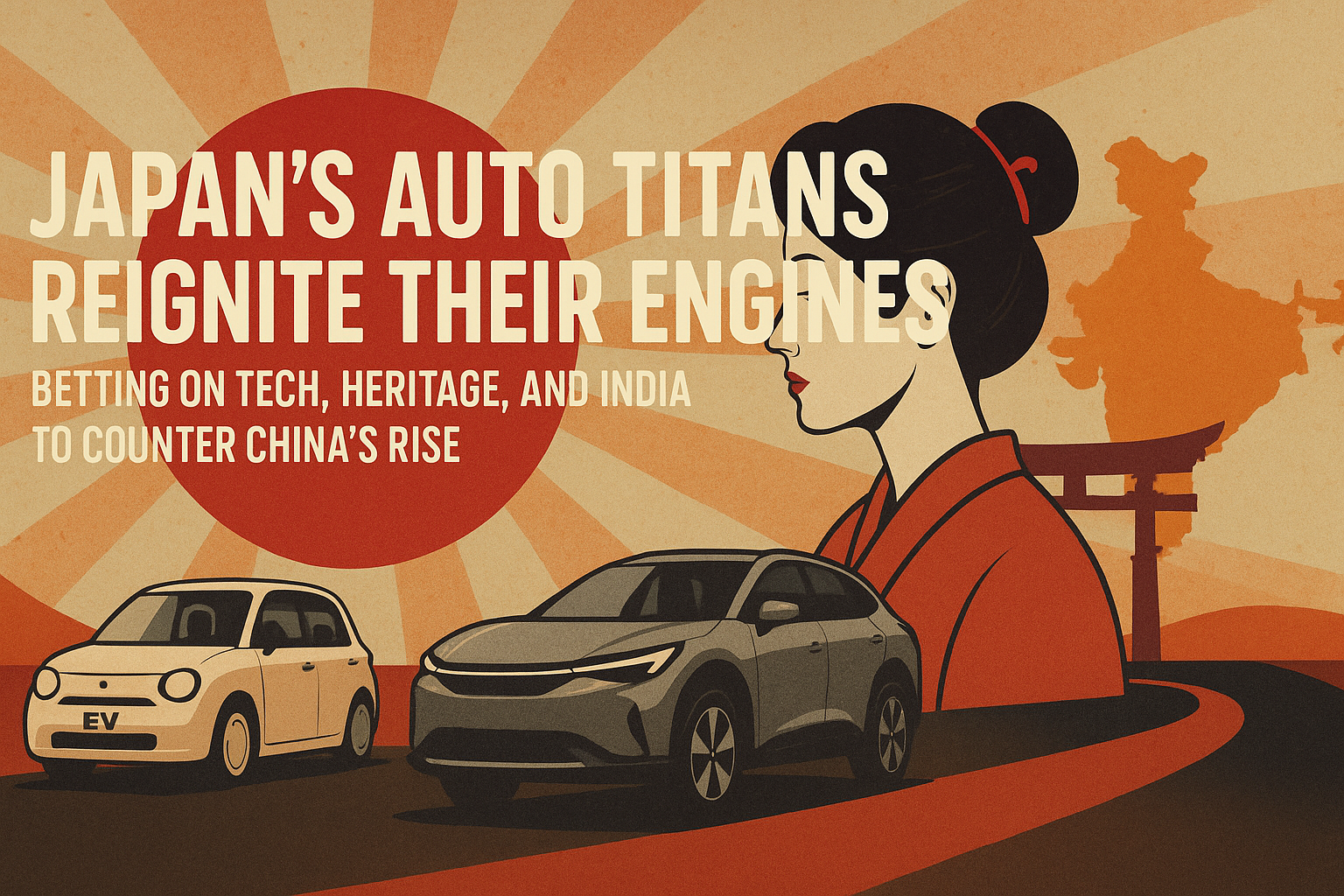As the global auto industry grapples with trade tensions, supply shortages, and a rapid electric transformation, Japan’s carmakers are rallying to reclaim their place in the driver’s seat. At the Japan Mobility Show 2025 in Tokyo, industry heavyweights—Toyota, Suzuki, Nissan, and Honda—unveiled bold strategies to revive their global standing. The message was clear: innovation, identity, and India will define the next chapter of Japan’s automotive story.
The Rejuvenation Push
Toyota’s chairman Akio Toyoda set the tone with an unusually candid reflection on Japan’s shrinking global influence. Acknowledging China’s meteoric rise—epitomized by BYD’s 72% surge in global sales—Toyoda lamented that “Japan as a nation seems to have lost some of its energy and dynamism.” Yet, his rallying cry was not one of resignation, but rebirth.
Toyota’s response came through the launch of its new luxury brand, Century, a symbol of Japan’s craftsmanship and cultural pride. “Century is not just another brand within Toyota,” Toyoda said. “We want to bring the spirit of Japan—the pride of Japan—out into the world.”
At the same show, Suzuki took a more pragmatic route. Chair Toshihiro Suzuki warned of the “growing Chinese challenge” and ruled out a direct price war. Instead, Suzuki is banking on product innovation. After debuting its first EV, the e-Vitara, for Europe, the company showcased its compact electric kei car, Vision e-Sky, designed to meet Japan’s unique urban demands.
Meanwhile, Nissan is battling back from tough losses with its Re:Nissan strategy, cutting costs while refreshing core models like the Leaf EV and Ariya. Plans to reintroduce the Patrol SUV to the Japanese market in 2027 are part of a broader effort to reconnect with loyal consumers amid an expected $1.8 billion loss for FY 2025–26.
For Honda, the show was about resilience. Despite profits halving due to U.S. tariffs, the company reaffirmed its long-term EV ambitions. The new Honda 0 Series—two SUVs and a sedan set to launch by 2027—underscores its commitment to clean mobility. “The shift toward EVs will continue,” said President Toshihiro Mibe, “and Honda is steadily preparing for the electrified era.”
The China Challenge
Japan’s automotive dominance in Asia has been steadily eroded by Chinese players over the past five years. A Bloomberg analysis (Nov 2024) showed Japanese market share falling sharply across China, Singapore, Thailand, Malaysia, and Indonesia, while BYD and others surged ahead.
In China alone, BYD gained 23% market share from 2019 to 2024, while Toyota, Honda, and Nissan collectively lost ground. Even in Southeast Asia—long a Japanese stronghold—market share tumbled from 50% to 35%.
What’s driving this shift? Aggressive pricing, a head start in EV technology, and Beijing’s strategic backing have made Chinese automakers formidable global contenders. For Japan, this represents not just an economic challenge but a cultural one—the need to reinvent while staying true to its identity.
India: The Bright Spot in a Shifting Landscape
If there’s one market keeping Japanese engines humming, it’s India. With Chinese automakers barely scratching the surface—BYD holds just 0.08% share—Japan’s manufacturers dominate half of the subcontinent’s car market.
Maruti Suzuki, the country’s largest automaker, commands a whopping 40% share, followed by Toyota (6%), Honda (1.5%), and Nissan (0.6%). A combination of GST rate cuts, strong festive demand, and an expected 5% industry growth in FY 2025–26 makes India a vital growth hub.
At the show, Honda’s India head Takashi Nakajima confirmed the company’s focus on India as one of its top three strategic markets, alongside Japan and the U.S. Honda plans to launch 10 new models, including seven SUVs by 2030, signaling a deep commitment.
For Suzuki, India is “the most critical market.” The automaker is gearing up for an eight-SUV offensive by 2030–31, while Toyota plans 15 new cars and model upgrades by the end of the decade.
And in a charming cultural twist, Suzuki’s chairman highlighted how the company is now selling Indian curry packets in Japan—over 100,000 sold so far—as a symbol of collaboration between the two nations.
The Road Ahead
Japan’s automotive titans are entering a defining decade. Between U.S. tariffs, chip shortages, and China’s growing dominance, the road is full of potholes. Yet, the momentum from the Japan Mobility Show suggests that the industry is not content to fade quietly.
With renewed focus on EV innovation, brand heritage, and partnerships with India, Japanese carmakers are steering toward a future that merges tradition with transformation. The race ahead may be tough, but Japan’s auto giants are once again ready to accelerate.
Takeaway:
In an era of shifting economic power and electrified mobility, Japan’s carmakers are reinventing themselves not just through technology but through purpose. And if Tokyo’s latest auto show is any indication, the world may soon witness a revival of Japan’s legendary automotive spirit—this time, powered by electric dreams and an Indian heartbeat.
Feel free to share your experiences and insights in the comments below. Let’s continue the conversation and grow together as a community of traders and analysts.
By sharing this experience and insights, I hope to contribute to the collective knowledge of our professional community, encouraging a culture of strategic thinking and informed decision-making.
As always, thorough research and risk management are crucial. The dynamic nature of financial markets demands vigilance, agility, and a deep understanding of the tools at your disposal. Here’s to profitable trading and navigating the election season with confidence!
Ready to stay ahead of market trends and make informed investment decisions? Follow our page for more insights and updates on the latest in the financial world!
For a free online stock market training by Yogeshwar Vashishtha (M.Tech IIT) this Saturday from 11 am – 1 pm, please sign up with https://pathfinderstrainings.in/training/freetrainings.aspx
Experience profits with my winning algo strategies – get a free one-month trial with ₹15 lakh capital! – https://terminal.algofinders.com/algo-terminal
Disclaimer
This article should not be interpreted as investment advice. For any investment decisions, consult a reputable financial advisor. The author and publisher are not responsible for any losses incurred by investors or traders based on the information provided.


